Frequently Asked Questions
File Preparation
What type of files should I send over?
We only accept PDF files. All other types of files must be converted to PDF, at an additional charge. You can send files to convert to PDF in the following types: JPG, JPEG, TIF, TIFF, and EPS.
We prefer that you send PDF with embedded or outlined fonts. PDF files are easier to handle and will likely speed up your turn-around. Remember to flatten your files before uploading.
For Roll Labels, we recommend designing:
Vector files (e.g. EPS or PDF)
300 DPI or higher
Use black (100% K)
For fine lines and text smaller than 9pt, use black (100% K) only
What color mode should my files be?
Your designs should always start and finish in CMYK color mode.
These colors are in RGB
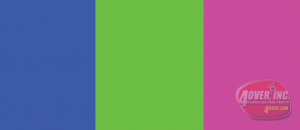
These are the same colors but in CMYK
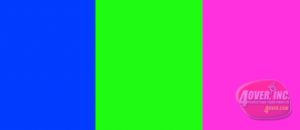
If you send us an RGB file, there is a chance that a color shift may occur and you may not be satisfied with your job.
What resolution should my file be?
Your artwork files should be at 300 dpi.
These are 72 dpi low res images:
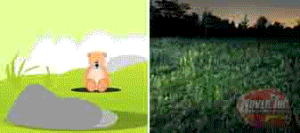
These are the same images but at 300 dpi:
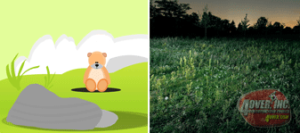
Low-resolution files may be printed as is or will be placed on hold until we receive new files, slowing your turn-around.
How should I set up my bleed?
Bleed must extend past the cut-line and will be trimmed from the product during the final cutting phase. When the image is required to extend all the way to the edge, bleed is needed to preserve the finished look and the quality of the final product.
Please keep all text at least 0.125″ inside the cut-line.
The bleed for Standard Products is 0.125″.
The bleed for Booklets and Presentation Folders is 0.25″.
We recommend using our templates at all times.
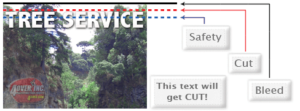
What is the safety margin?
Does your piece have any images, text or other elements close to the page edge? If too close, it may get cut off. Establish a no-go “safety margin” of at least 1/8″ from the edge of the final trim size. To avoid any images or text being cut off when the piece is trimmed, do not place them in the safety margin.
What is the best image resolution for print?
While your computer screen will display low resolution images well, when printed they will look rough, blurry and jagged. For best printing results, a resolution of at least 300 dpi is recommend. Files with resolution lower than 300 dpi can be printed, but the results may be unsatisfactory.
What about borders?
Does your piece contain a graphic or artistic border close to the paper edge? See related Bleed above and Safety Zone below. When paper is trimmed there is a cutting tolerance of 1/16″ which may result in uneven borders. For this reason we do not recommend borders. However, if they are necessary in your piece, the border should be at least 1/4″ thick and at least 3/8″ from the bleed line. Perfect trimming is not guaranteed.
What about fonts?
Are you using vector-based software such CorelDraw, Adobe Illustrator, Adobe InDesign, or Adobe Freehand? For vector files such as these all text must be converted to outlines before creating the file (preferably PDF) you send us.
Are you using a bitmap-based (a.k.a. raster) software application such as Adobe Photoshop? For bitmap files such as these, simply flatten the image. Avoid font sizes smaller than 8 pts or fonts that are very narrow as these may not print, or will lack crispness, or may not display well against dark backgrounds.
What is the minimum line thickness?
Do you have lines on your piece? All lines should be at least .25 pts thick to make them printable. Thinner lines may display on your screen but be too thin to print.
Bleed/Trim
What is bleed?
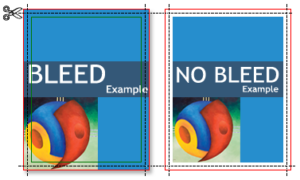
Bleed refers to a background color, graphic, or image that extends to the edge of the finished paper size and beyond. It’s difficult for printing equipment to apply ink up to the cut edge of a sheet of paper. So an extra .125″ (3mm) margin is typically added on each side of the design, enabling the background color, graphic, or image to extend past (i.e., “bleed off”) the paper’s final trim edge. This extra bleed area will be cut off the printed sheet. For example, a letterhead sheet that incorporates bleed in its design will be 8.75″ x 11.25″ before being trimmed to a finished size of 8.5″ x 11″.
How do I create bleed in my design?
To create bleed in your design, simply make sure the background color, graphic, or image you want it to bleed extends off the the final trim edge of the page by .125″ (3mm).
If you are creating your file in an application such as Photoshop, you must make your document height and width dimensions .25″ (6mm) larger than your final trim size. For example, if the finished size is 8.5″ x 11″ then make your document 8.75″ x11.25″. Position guides that are .125″ from each edge. For design purposes, these guides will represent where the paper (and any of your design elements) will be cut.
Position any background color, graphic, or image that you want to bleed so they extended past your guides, all the way to the outside edge of the document. Remember, the extra .125″ will be cut off after your piece is printed.
If you are using InDesign, bleed can be set when creating the document. If the document has already been created, go to File>Document Setup, and you will find bleed settings there.
Other Terms
What are corner crop marks?
Corner crop marks are printed around the edges of a printed item to show the printer where to trim the paper.
What is CMYK vs. RGB?
RGB (Red Green Blue) is a color mode designed for electronic screens. CMYK (Cyan Magenta Yellow Key) is designed for printers, using pigment of ink or dye colors.
Adobe Illustrator defaults to CMYK. Adobe Photoshop defaults to RGB, but you can change its settings to CMYK (Image > Mode) to ensure that your colors will not change when printed.
What is dpi?
DPI is dots per inch—how many individual dots can be placed on a line within an inch. This is a measure of the resolution (the quality or precision) of a printed item.
What is postal permit - indicia?
An indicia is a graphic used in place of a stamp to indicate to the United States Postal Service that an item will be paid for with a mailing permit.
What is a USPS non-profit authorization number?
The United States Postal Service allows non-profit organizations to send mail at reduced rates. Organizations that have applied for and received a non-profit organization number include it on the postage statement submitted with mailings.
What are overs and unders?
An over and under is a range within which the quantity of an order will be delivered. For example, an order of 1000 items with an over/under of +/- 10% may be delivered with as few as 900 and as many as 1100 items.
What is banding?
Banding is when a gradient transition from a light color to a dark color is not smooth has visually distinct bands of color. This happens when the gradient area is too small and can be solved by allowing enough room for a smooth gradient. Check digital files before submission for banding.
What is overprint?
Overprint is a setting where inks are intentionally overlapped. It can produce unexpected results, so we recommend turning off overprint in all files before submission.
What is the difference between raster and vector?
Raster-based images are made up of tiny scales. Vector images, such as illustrations from Adobe Illustrator, are made up of mathematical calculations.
If a raster image is enlarged enough, it will start to lose quality (becoming pixelated). A vector image can be changed to any size without quality loss.
Billing
For payment related-questions, call 419-994-4166 ext 226.
